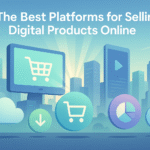The Pros and Cons of Selling Digital Products Online
In today’s digital age, selling digital products online has become a lucrative endeavor for many entrepreneurs. Whether you’re a seasoned business owner or a budding creator, digital products offer a unique opportunity to scale your business without the constraints of physical inventory. But, as with any business decision, there are both benefits and drawbacks to consider. Let’s dive into the pros and cons of selling digital products online. 📈💻
Table of Contents
Introduction
Digital products are intangible goods that can be delivered electronically. Examples include e-books, online courses, software, and digital art. As more consumers embrace the convenience of digital downloads, the market for these products continues to grow. But before you jump in, it’s essential to weigh the pros and cons to ensure this business model aligns with your goals and capabilities.
Pros of Selling Digital Products
1. Low Overhead Costs
One of the most significant advantages of selling digital products is the low overhead costs. Unlike physical products, digital goods don’t require manufacturing, shipping, or storage. This means you can start your business with minimal investment, making it an attractive option for those on a budget.
2. Scalability
Digital products are inherently scalable. Once you’ve created a product, you can sell it an unlimited number of times without incurring additional production costs. This scalability allows you to grow your business quickly and efficiently.
3. Global Reach
With digital products, you have the potential to reach a global audience. Language barriers and shipping restrictions are virtually non-existent, allowing you to market your products to customers worldwide. 🌍
4. Passive Income Potential
Digital products offer the opportunity to earn passive income. Once your products are created and your sales funnel is set up, you can generate revenue with minimal ongoing effort. This passive income stream can provide financial stability and freedom.
5. Easy Updates and Improvements
Unlike physical products, digital goods can be easily updated and improved. If you receive feedback or identify areas for enhancement, you can quickly make changes and provide your customers with the latest version. This flexibility enhances customer satisfaction and can lead to repeat sales.
Cons of Selling Digital Products
1. Intellectual Property Concerns
One of the main challenges of selling digital products is the risk of piracy and unauthorized distribution. Protecting your intellectual property can be difficult, and once your products are shared without your permission, it can be challenging to control.
2. High Competition
The low barrier to entry for digital products means there’s a lot of competition. Standing out in a crowded market requires effective marketing strategies, a strong brand presence, and a high-quality product.
3. Technical Challenges
Creating and delivering digital products requires a certain level of technical expertise. From designing your product to setting up a sales platform, the technical aspects can be daunting for those who are not tech-savvy.
4. Lack of Tangibility
Some customers prefer the tangibility of physical products. Digital goods can feel less personal, and convincing customers of their value may require extra effort in your marketing and sales approach.
5. Customer Support and Refunds
Handling customer support and refund requests can be time-consuming. Unlike physical products, digital goods are often non-refundable, which can lead to customer dissatisfaction if not communicated clearly upfront.
Conclusion
Selling digital products online offers numerous advantages, from low overhead costs to global reach and scalability. However, it’s not without challenges. By understanding the pros and cons, you can make informed decisions about whether this business model is right for you. With the right strategies and mindset, digital products can be a profitable and rewarding venture. 🎉
FAQs
What types of digital products can I sell online?
You can sell a wide variety of digital products, including e-books, online courses, software, digital art, music, and more. The key is to identify a product that aligns with your expertise and market demand.
How can I protect my digital products from piracy?
To protect your digital products, consider using DRM (Digital Rights Management) software, watermarking, and secure delivery platforms. Additionally, clearly communicate your terms of use and copyright policies to discourage unauthorized sharing.
What platforms can I use to sell digital products?
There are several platforms available for selling digital products, including Shopify, Gumroad, Etsy, and Amazon. Choose a platform that aligns with your business model and offers the features you need, such as secure payment processing and digital delivery.
Can I sell digital products alongside physical products?
Yes, many businesses successfully sell both digital and physical products. This approach allows you to diversify your offerings and cater to a broader audience.
Embarking on the journey of selling digital products can be an exciting and profitable venture. By understanding the landscape and preparing adequately, you can tap into this growing market with confidence.
Free Download!
Best Digital Product – eBooks, templates, AI tools, courses, and mor






